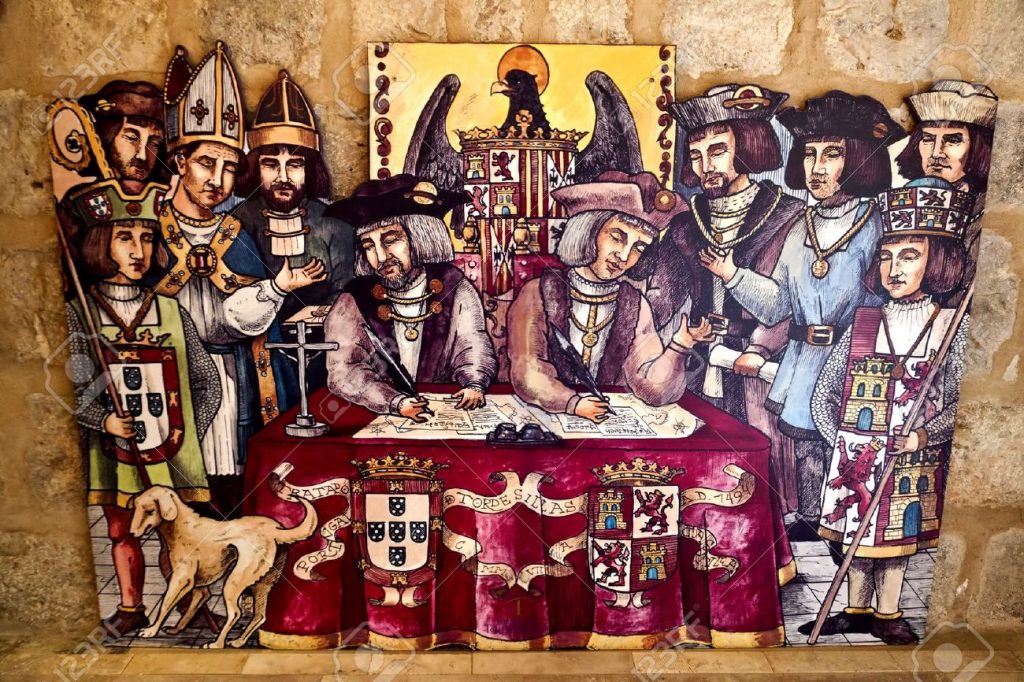The fifteenth century saw many changes for the nations of the “Old World.” It was the beginning of the age of exploration, and with that exploration came the exportation of their cultures, religion, and political power across vast, unexplored territories. What followed would be centuries of wars, treaties, and technological improvements that accelerated European dominance over Africa, the Americas, and parts of Asia. Two specific powers emerged during this early period as rivals: Portugal and Spain, with the latter eventually eclipsing the former through economic and political means. One event that helped propel Spain ahead of its competitor and gain numerous advantages was the treaty of Tordesillas.
The story, however, begins with Portugal taking the initial lead. In the early-fifteenth century, Portugal had begun to colonize several small islands in the Atlantic Ocean and some islands along the West African coast. It was not until 1488 that Bartolomeu Dias, appointed by King John II of Portugal, rounded the Cape of Good Hope and opened the way for Portuguese merchants to trade directly with India, and eventually with the East Indies.1 Spain also sought to establish trade with the East Indies, but only after a different route became possible subsequent to the voyages of Christopher Columbus.
Upon his arrival to the Americas, Columbus claimed all of the lands he visited for Spain. On his return, the Italian explorer stopped in Portugal and met with John II. After having learned of Columbus’ discoveries and the claims he had made for Spain, the Portuguese monarch grew upset and made his own claims to these lands. The king cited two pieces of writing as justification: the Treaty of Alcáçovas (1479) and the papal bull, Aeterni Regis (1481). These documents declared that Spain would control the surrounding area of the Canary Islands (near the coast of present-day Morocco) and Portugal would possess all of the lands to the west and south of this location.2 King John II believed that the lands discovered by Columbus were in the areas under Portuguese control as set forth by the 1479 treaty and the 1481 papal document. However, the Spanish monarchs, worried about their neighboring country’s claims, petitioned the leader of the Roman Catholic Church, Pope Alexander VI, to acknowledge their own claims to these lands.

The Supreme Pontiff Alexander VI (Roderic Borgia), a native of Aragon and personal friend of Ferdinand II, agreed with the Spanish monarchs and recognized their claims to these “new” territories.3 On May 4, 1493, in an effort to forestall future territorial disputes between Spain and Portugal, he issued a new papal bull, Inter Caetera Divinae, which formed an imaginary line running straight from the North and South poles. This line was located 100 leagues (345 miles) west of the Cape Verde Islands, which gave Spain control over all the territories west of this line, and Portugal gained control over those east of the line. The pope, however, specified that those lands already claimed by Christian sovereign powers would remain under their control.4
Spanish interests in the spice trade heavily influenced the position of the line since the monarchs believed the islands rich in spices were west of where Columbus had landed.5 If this had been the case, then Portugal would have effectively been excluded from trade with East Asia, giving all access to Spain. But Pope Alexander VI went even further with another papal bull, Dudum Siquidem, issued September 26, 1493, which gave Spain the right to claim lands discovered while traveling westward even if they fell in the Portuguese areas but had not yet been possessed by Portugal.6 John II was made furious by these bulls and threatened to send a fleet to Hispaniola to prevent the Spanish from colonizing those new areas. Thus, began new negotiations overseen by the same pope in 1494.

After much discussion and debate, the two Catholic powers agreed to place the imaginary line 370 leagues (1,277 miles) west of the Cape Verde Islands. Just like in Inter Caetera Divinae, Spain would possess all areas west of the line and Portugal all those east of the line. The treaty was ratified June 7, 1494 by both parties in the Castilian town of Tordesillas, and it was later recognized by Pope Julius II (successor of Alexander VI) in a papal bull in 1506.7 The treaty did have some flaws though, since it never clarified a standard for a league, (units of measure varied among the two countries), and it failed to mention which side of the Cape Verde Islands the measuring distance would start from.8 This led to a difficulty when establishing borders between the two colonial powers, because no one knew where the exact location of the line lay. The Treaty of Tordesillas was also rejected by England, France, and the Netherlands since the treaty excluded them from exploring the New World.9 As history later revealed, the treaty greatly benefited the Spanish monarchs and their economy. King Ferdinand II and Queen Isabella I gained vast amounts of colonial territory, which included colossal deposits of silver and gold. All of this eventually raised the prestige of Spain and made it the dominant power in Central and South America for centuries.
- Global Events: Milestone Events Throughout History, 2014, s.v. “Spain and Portugal Sign the Treaty of Tordesillas.” ↵
- Gale Encyclopedia of U.S. Economic History, 2000, s.v. “Tordesillas, Treaty of.” ↵
- Iberia and the Americas: Culture, Politics, and History, 2005, s.v. “Tordesillas, Treaty of (1494).” ↵
- Global Events: Milestone Events Throughout History, 2014, s.v. “Spain and Portugal Sign the Treaty of Tordesillas.” ↵
- Encyclopedia of Western Colonialism since 1450, 2007, s.v. “Treaty of Tordesillas,” by Alexander M. Zukas. ↵
- Iberia and the Americas: Culture, Politics, and History, 2005, s.v. “Tordesillas, Treaty of (1494).” ↵
- American Eras: Primary Sources, 2015, s.v. “Treaty of Tordesillas (Excerpt).” ↵
- Iberia and the Americas: Culture, Politics, and History, 2005, s.v. “Tordesillas, Treaty of (1494).” ↵
- American Eras: Primary Sources, 2015, s.v. “Treaty of Tordesillas (Excerpt).” ↵



56 comments
Maria Fernanda Guerrero
Great article! I didn’t know much about European history, but I enjoyed reading this specifically since it allowed me to conceptualize the true nature of ambition Europeans had to gain power. You gave great detail on their struggles on gaining power. The Treaty of Tordesilla was a foundation element to understand the relationship between America and Spain. Thank you for this informative piece.
A'marie Pollard
I believe the Treaty of Tordesillas represents a vital moment in history, where the ambitions and power struggles of the European nations shaped the course of global exploration and colonization. It’s a reminder of the impact of geopolitical decisions on the lives of countless people across the world. The treaty’s legacy continues to reverberate through history, reminding us of the complexities and consequences of colonialism for generations to come. Thank you for taking the time to write about such a impactful moment in history!
Carina Martinez
This article was very informative for someone who has not heard much of the “old world” as the article mentions. Although the article was not the longest it provided a lot of detail of the history of Spain and Portugal. I did not realize the involvement Columbus had in this piece of history and claiming all the land for Spain. Very interesting!
Nicole Estrada
The Treaty of Tordesillas carefully situated Spain as a strong power, allowing the Pope to claim undiscovered regions despite severe opposition. This resulted in Spanish colonialism, which explains why Spanish is so prevalent in Latin America, as opposed to Brazil’s Portuguese origin. The pact emphasizes the power of Spain, Portugal, and the Papal State, stressing Portugal’s early mistake and later overshadowing by Spain. It reflects the era’s global maneuvers. I appreciated reading this article because I had no clue about this Treaty. Great work on the article it was very informative!
Gaitan Martinez
I have never heard of the Treaty of Tordesillas. It was a very interesting read, it’s so crazy how a simple document is used to create laws and boundaries between nations. Again, I didn’t know about this treaty before, and I’m sure I’m not the only one. However, it’s crazy to think about that there are many others who may not know of this treaty, and it’s a significant treaty that easily impacted our world.
Fernando Milian
This is the first time I heard about the Treaty of Tordesillas. I wonder if treaties back then were more influenced by religious authority, given the significant role the Pope played in the agreement. I also have doubts about the diplomatic norms of the era. Did they have diplomacy at all? It is difficult to say if we see the way in which the great powers of the moment divided the territories that they were discovering.
I learned something new today thanks to this article.
Martin Martinez
It is a bit comical that Spain and Portugal would expect other European sovereigns to recognize the Treaty de Tordesillas, given how much Spain received according to its terms. While traces of Spanish history are nothing but obvious in the Southern United States and Central/South America, it’s nice, at least for me, to be reminded of why things are the way they are in these areas.
Jonathan Flores
This article does a great job at being highly informative of a Treaty that likely most people do not know too much about. This treaty, as you have expertly outlined, was a fundamental document of our history that highlights some of the most important facets of human society in the Old World. With the power of he Catholic Church mentioned, it displays how important Religion is across the world, which we still see today. Additionally, this was especially interesting to me as I am a history buff and it seems that people often overlook the impact of Spain and Portugal in the history books.
Lauren Sahadi
This article talked about the Treaty of Tordesillas and its historical context. It was a really great portrayal of the rivalry between Portugal and Spain and the events that went on during this time. This was a very well written article. It clearly explained the events that happened and painted a picture that was very easy to follow along. It was interesting to read, great job.
Carlos Alonzo
Good evening, I enjoy the political cartoon that shows the creation of the treaty. This was an interesting article that explores the creation of the Treaty of Tordesillas of 1494. It interesting how religion was a factor that influenced the early treaties. Primarily, I believe that the idea of Catholicism was important for the earlier treaties because this indicated a divinity to the laws.